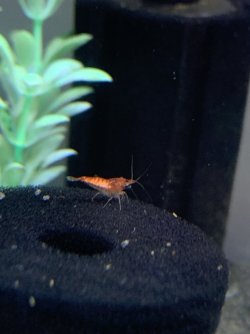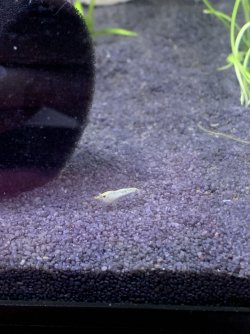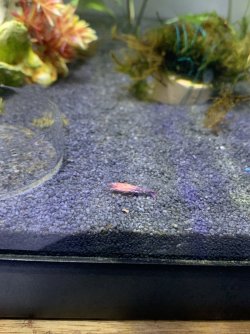Atmosphere123
New Member
Have included as much info as I can think of to help so apologies for length.
I have a 60l shrimp only tank, also used to grow out plants. Originally stocked two weeks ago with 30 RCS bought from a local hobbyist plus a couple oranges I already had. Filter was cycled previously in a tank with 6 large platys and I have since added a second smaller sponge filter to help cope with extra bio load.
I have noticed a few shrimp deaths of various ages, usually spaced a few days apart and have caught them eating another shrimp. I pulled a dead one yesterday and the one I pulled today was blue on their back half for some reason.(see pictures below)
I have also noticed a few of them turning white on the inside and was wondering if anyone knows the cause of this as most sites just tell you that it’s going to die and not much other information(see pictures below). I had a red rilli that turned opaque inside and was eaten and also had a shrimp turn completely white with no other colour.(see pictures below)
Tank temperature is currently 22.6 and there is a heater in there
Tank parameters api master test kit)
api master test kit)
Ph-8.2
Ammonia-0.25ppm
Nitrite-0ppm
Nitrate-20-40ppm
dechlorinated tap water parameters:
Ph-7.4-7.8
Ammonia-0.25ppm
Nitrite-0ppm
Nitrate-10-20ppm
(dechlorinated with fluval water conditioner)
Have now switched to Seachem Prime after discovering ammonia in tap water but haven’t measured tap again since.
Don’t have a Gh and Kh test kit yet but my water is hard
Have unfortunately overfed them a little to try out some Shrimp King complete and Protein aswell as some Bacteria AE that I bought so I expect that’s why the ammonia isn’t at 0
Water changes are done with 0.25 ml of prime in a 10l bucket and I scoop out a plastic cups worth and drip it into the tank at 1-2 drips per second using knotted airline tubing and cup is refilled probably twice a day I syphon about 5l of water out and add 5l back over the space of a few days and use any left over water in my other tanks
I have approx 20 Red cherries left, I have never been able to keep shrimps alive previously, I’m aware my mistake this time is over feeding but I have tried many different things I’ve watched in YouTube videos by shrimp keepers and none have seemed to work for me so any info would be great
can include a list of plants in the tank if that makes a difference.
Thanks
I have a 60l shrimp only tank, also used to grow out plants. Originally stocked two weeks ago with 30 RCS bought from a local hobbyist plus a couple oranges I already had. Filter was cycled previously in a tank with 6 large platys and I have since added a second smaller sponge filter to help cope with extra bio load.
I have noticed a few shrimp deaths of various ages, usually spaced a few days apart and have caught them eating another shrimp. I pulled a dead one yesterday and the one I pulled today was blue on their back half for some reason.(see pictures below)
I have also noticed a few of them turning white on the inside and was wondering if anyone knows the cause of this as most sites just tell you that it’s going to die and not much other information(see pictures below). I had a red rilli that turned opaque inside and was eaten and also had a shrimp turn completely white with no other colour.(see pictures below)
Tank temperature is currently 22.6 and there is a heater in there
Tank parameters
Ph-8.2
Ammonia-0.25ppm
Nitrite-0ppm
Nitrate-20-40ppm
dechlorinated tap water parameters:
Ph-7.4-7.8
Ammonia-0.25ppm
Nitrite-0ppm
Nitrate-10-20ppm
(dechlorinated with fluval water conditioner)
Have now switched to Seachem Prime after discovering ammonia in tap water but haven’t measured tap again since.
Don’t have a Gh and Kh test kit yet but my water is hard
Have unfortunately overfed them a little to try out some Shrimp King complete and Protein aswell as some Bacteria AE that I bought so I expect that’s why the ammonia isn’t at 0
Water changes are done with 0.25 ml of prime in a 10l bucket and I scoop out a plastic cups worth and drip it into the tank at 1-2 drips per second using knotted airline tubing and cup is refilled probably twice a day I syphon about 5l of water out and add 5l back over the space of a few days and use any left over water in my other tanks
I have approx 20 Red cherries left, I have never been able to keep shrimps alive previously, I’m aware my mistake this time is over feeding but I have tried many different things I’ve watched in YouTube videos by shrimp keepers and none have seemed to work for me so any info would be great
can include a list of plants in the tank if that makes a difference.
Thanks








